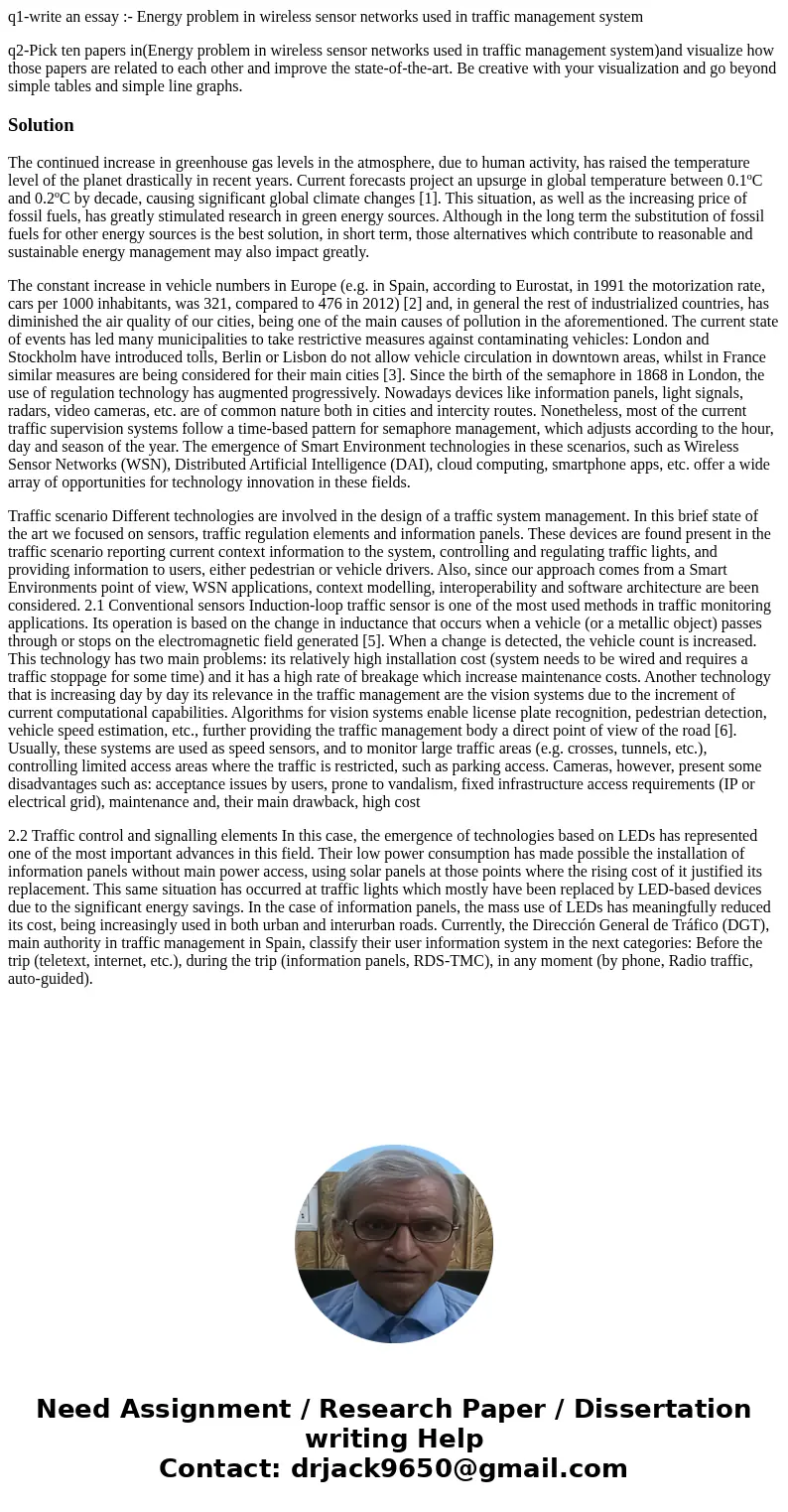q1write an essay Energy problem in wireless sensor networks
q1-write an essay :- Energy problem in wireless sensor networks used in traffic management system
q2-Pick ten papers in(Energy problem in wireless sensor networks used in traffic management system)and visualize how those papers are related to each other and improve the state-of-the-art. Be creative with your visualization and go beyond simple tables and simple line graphs.
Solution
The continued increase in greenhouse gas levels in the atmosphere, due to human activity, has raised the temperature level of the planet drastically in recent years. Current forecasts project an upsurge in global temperature between 0.1ºC and 0.2ºC by decade, causing significant global climate changes [1]. This situation, as well as the increasing price of fossil fuels, has greatly stimulated research in green energy sources. Although in the long term the substitution of fossil fuels for other energy sources is the best solution, in short term, those alternatives which contribute to reasonable and sustainable energy management may also impact greatly.
The constant increase in vehicle numbers in Europe (e.g. in Spain, according to Eurostat, in 1991 the motorization rate, cars per 1000 inhabitants, was 321, compared to 476 in 2012) [2] and, in general the rest of industrialized countries, has diminished the air quality of our cities, being one of the main causes of pollution in the aforementioned. The current state of events has led many municipalities to take restrictive measures against contaminating vehicles: London and Stockholm have introduced tolls, Berlin or Lisbon do not allow vehicle circulation in downtown areas, whilst in France similar measures are being considered for their main cities [3]. Since the birth of the semaphore in 1868 in London, the use of regulation technology has augmented progressively. Nowadays devices like information panels, light signals, radars, video cameras, etc. are of common nature both in cities and intercity routes. Nonetheless, most of the current traffic supervision systems follow a time-based pattern for semaphore management, which adjusts according to the hour, day and season of the year. The emergence of Smart Environment technologies in these scenarios, such as Wireless Sensor Networks (WSN), Distributed Artificial Intelligence (DAI), cloud computing, smartphone apps, etc. offer a wide array of opportunities for technology innovation in these fields.
Traffic scenario Different technologies are involved in the design of a traffic system management. In this brief state of the art we focused on sensors, traffic regulation elements and information panels. These devices are found present in the traffic scenario reporting current context information to the system, controlling and regulating traffic lights, and providing information to users, either pedestrian or vehicle drivers. Also, since our approach comes from a Smart Environments point of view, WSN applications, context modelling, interoperability and software architecture are been considered. 2.1 Conventional sensors Induction-loop traffic sensor is one of the most used methods in traffic monitoring applications. Its operation is based on the change in inductance that occurs when a vehicle (or a metallic object) passes through or stops on the electromagnetic field generated [5]. When a change is detected, the vehicle count is increased. This technology has two main problems: its relatively high installation cost (system needs to be wired and requires a traffic stoppage for some time) and it has a high rate of breakage which increase maintenance costs. Another technology that is increasing day by day its relevance in the traffic management are the vision systems due to the increment of current computational capabilities. Algorithms for vision systems enable license plate recognition, pedestrian detection, vehicle speed estimation, etc., further providing the traffic management body a direct point of view of the road [6]. Usually, these systems are used as speed sensors, and to monitor large traffic areas (e.g. crosses, tunnels, etc.), controlling limited access areas where the traffic is restricted, such as parking access. Cameras, however, present some disadvantages such as: acceptance issues by users, prone to vandalism, fixed infrastructure access requirements (IP or electrical grid), maintenance and, their main drawback, high cost
2.2 Traffic control and signalling elements In this case, the emergence of technologies based on LEDs has represented one of the most important advances in this field. Their low power consumption has made possible the installation of information panels without main power access, using solar panels at those points where the rising cost of it justified its replacement. This same situation has occurred at traffic lights which mostly have been replaced by LED-based devices due to the significant energy savings. In the case of information panels, the mass use of LEDs has meaningfully reduced its cost, being increasingly used in both urban and interurban roads. Currently, the Dirección General de Tráfico (DGT), main authority in traffic management in Spain, classify their user information system in the next categories: Before the trip (teletext, internet, etc.), during the trip (information panels, RDS-TMC), in any moment (by phone, Radio traffic, auto-guided).

 Homework Sourse
Homework Sourse